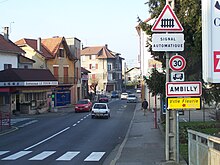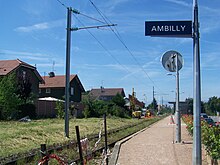Ambilly
| Ambilly | ||
|---|---|---|

|
|
|
| region | Auvergne-Rhône-Alpes | |
| Department | Haute-Savoie | |
| Arrondissement | Saint-Julien-en-Genevois | |
| Canton | Annemasse | |
| Community association | Annemasse-Les Voirons-Agglomération | |
| Coordinates | 46 ° 12 ' N , 6 ° 13' E | |
| height | 410-434 m | |
| surface | 1.25 km 2 | |
| Residents | 6,385 (January 1, 2017) | |
| Population density | 5,108 inhabitants / km 2 | |
| Post Code | 74100 | |
| INSEE code | 74008 | |
| Website | www.ambilly.fr | |
Ambilly is a French commune in the department of Haute-Savoie in the region of Auvergne Rhône-Alpes .
geography
Ambilly is located at 426 m , about one kilometer west of Annemasse and six kilometers east of the city of Geneva (straight line). The municipality extends on the plateau between the valleys of the Arve in the south and the Foron in the north, on the outskirts of Annemasse, in the immediate vicinity of the border with Switzerland .
The area of the 1.25 km² large municipal area includes a section in the lower Arve valley. The northern border runs along the gently meandering Foron (tributary of the Arve). From here, the municipality extends southward over the Ambilly plateau (here, at 435 m, the highest elevation in the municipality is reached) to the Arve valley, around 20 m lower, northeast of the Salève .
In addition to the old village, Ambilly includes numerous new residential and commercial quarters as well as the La Martinière settlement ( 430 m ). The neighboring municipalities of Ambilly are Ville-la-Grand and Annemasse in the east, Gaillard in the south, and the Swiss municipalities Thônex and Puplinge in the northwest.
history
The municipal area of Ambilly was already settled in Roman times, which could be proven on the basis of the foundations of a Roman country estate and numerous other finds. Ambilly is first mentioned in writing in 859 under the name Ambiliaci ; from 1022 the name Ambiliacum has been handed down. The place name goes back to the Gallo-Roman personal name Ambilius and means something like Ambilius' estate .
In the Middle Ages , Ambilly belonged first to the Bishops of Geneva, and later to the Counts of Geneva. In the 14th century the village passed to the Counts of Savoy . Due to the Treaty of Turin in 1816 Ambilly lost all of its territory north of the Foron to Vandœuvres in the Swiss canton of Geneva . Shortly afterwards, in 1818, the municipalities of Ambilly and Gaillard were merged to form the new municipality of Ambilly-Gaillard, but separated again in 1843.
Attractions
Ambilly Church was built in 1941.
population
| Population development | |
|---|---|
| year | Residents |
| 1962 | 3,254 |
| 1968 | 4,337 |
| 1975 | 5,582 |
| 1982 | 5,224 |
| 1990 | 5,904 |
| 1999 | 5,808 |
| 2005 | 5,745 |
With 6385 inhabitants (as of January 1, 2017), Ambilly is one of the larger municipalities in the Haute-Savoie department. Significant growth rates in terms of the number of inhabitants were recorded especially during the 1960s and 1970s. Today, almost the entire municipality is built over, which is why the number of inhabitants has been falling slightly for several years. The settlement area of Ambilly has merged seamlessly with that of Annemasse, Gaillard and Thônex.
Daughters and sons of the church
- Charlie Conord (* 1990), track cyclist
- Antonin Guigonnat (* 1991), biathlete
- Jean Monod (1765–1836), Reformed pastor and theologian
- Marie-Luce Waldmeier (* 1960), ski racer
Economy and Infrastructure
Ambilly was a predominantly agricultural village until the 20th century . Since the 1950s, it gradually developed into a residential suburb of Annemasse and Geneva. Today there are numerous small and medium-sized businesses, as well as construction and trading companies and companies in the service sector. Ambilly is the location of Annemasse-Bonneville Hospital.
The place is well developed in terms of traffic. It is on the main road from Annemasse to Geneva. The closest connection to the A40 motorway is around 2 km away. On the eastern edge of the village is the Annemasse train station with train connections to Genève-Eaux-Vives, Thonon-les-Bains, Annecy and Bellegarde.
As part of the electrification of the Geneva State Railways (CFEG), a stop was set up on September 28, 1986 on the Annemasse – Geneva – Eaux – Vives line. The CFEG ceased operations as part of the construction of the new Cornavin – Eaux-Vives – Annemasse railway on March 31, 2013.


